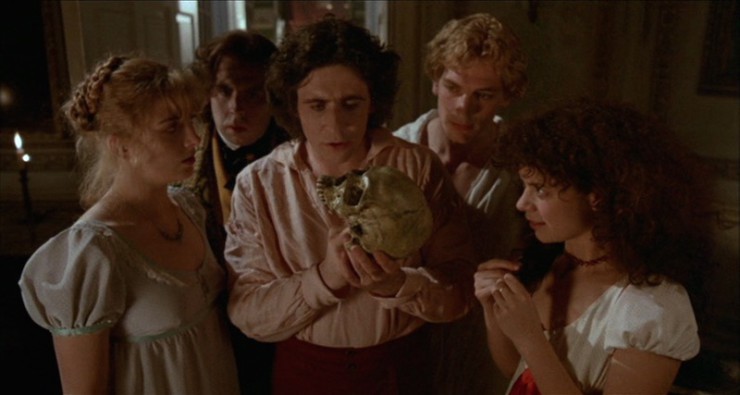Frankenstein came to Mary Wollstonecraft Shelley in a waking dream between 2 and 3 a.m. on June 16, 1816. The waking part came from the moonlight pressing at the shutters of Shelley’s room at Villa Diodati. The dream part came from a dare made by Lord Byron, one of her fellow vacationers at the villa on Lake Geneva, to come up with the scariest story. The dare came about when bored intellectuals were forced to remain indoors as dreary weather prevented them from enjoying Lake Geneva. That dreary weather was caused by an incredible volcanic eruption in Indonesia the year before, making 1816 the Year Without a Summer.
Few stories’ origins have been so heavily mythologized and retraced as Frankenstein‘s, thanks to recent research (into volcanoes, astronomy, and centuries-old journals). At the same time, as we mark the bicentennial of Shelley dreaming up her Creature and his tortured creator (and the bicentennial of the novel’s actual publication, in 1818), scholars and futurists are also looking forward. In particular, the Frankenstein Bicentennial Project, NaNoWriMo (National Novel Writing Month), and others have zeroed in on one particular aspect of Frankenstein‘s genesis: the dare.
Frankenstein was conceived on a dare, after all; truly a spiritual ancestor of NaNoWriMo! #Frankenstein200
— NaNoWriMo (@NaNoWriMo) June 20, 2016
Earlier this week, NaNoWriMo held a tweet-chat with author Elizabeth Bear to talk #Frankenstein200, female science fiction writers, and (the magic word) dares. In discussing what holds writers back from trying their hands at sci-fi, Bear pulled from Frankenstein itself:
@NaNoWriMo @sushimustwrite Shelley doesn’t focus on the nuts and bolts, after all. Even the idea that the monster is (1/2) #Frankenstein200
— Elizabeth Bear (@matociquala) June 21, 2016
@NaNoWriMo @sushimustwrite infused with life by lightning comes from only one line in the text! (2/2) #Frankenstein200
— Elizabeth Bear (@matociquala) June 21, 2016
She also shared her own experiences with dares:
.@grantfaulkner #Frankenstein200 I’ve done a few things like that. Mostly, dares get me to write things I wouldn’t think of on my own.
— Elizabeth Bear (@matociquala) June 21, 2016
It’s fitting that the folks behind NaNoWriMo, with its supportive community of writers and helpful prompts and jumping-off points, would fixate on the part about storytellers challenging one another to come up with ever more imaginative and spooky ideas. But they’re not the only ones behind #Frankenstein200. Arizona State University has issued the Frankenstein Bicentennial Dare in the form of two writing contests. There’s the #Frankenstein200 fiction challenge, presented by NaNoWriMo and the Chabot Space & Science Center, to tell your own scary story in 1,800 words or fewer:
Frankenstein is a classic of Gothic literature—a gripping, tragic story about Victor Frankenstein’s failure to accept responsibility for the consequences of bringing new life into the world. In this dare, we’re challenging you to write a scary story that explores the relationship between creators and the “monsters” they create.
Almost anything that we create can become monstrous: a misinterpreted piece of architecture; a song whose meaning has been misappropriated; a big, but misunderstood idea; or, of course, an actual creature. And in Frankenstein, Shelley teaches us that monstrous does not always mean evil—in fact, creators can prove to be more destructive and inhuman than the things they bring into being.
Bear will provide feedback for the winners of the fiction contest. There’s also a nonfiction contest, presented by Creative Nonfiction magazine:
Creative Nonfiction magazine is daring writers to write original and true stories that explore humans’ efforts to control and redirect nature, the evolving relationships between humanity and science/technology, and contemporary interpretations of monstrosity.
Essays must be vivid and dramatic; they should combine a strong and compelling narrative with an informative or reflective element and reach beyond a strictly personal experience for some universal or deeper meaning. We’re open to a broad range of interpretations of the “Frankenstein” theme, with the understanding that all works submitted must tell true stories and be factually accurate. Above all, we’re looking for well-written prose, rich with detail and a distinctive voice.
The Frankenstein Bicentennial Project has multifaceted goals: On one side, it seeks to infuse future endeavors in science (and especially engineering) with a consideration of the ethics involved in such inventions and explorations; on the other, it invites humanists and artists to engage with the aforementioned scientific endeavors, to contextualize and understand the ongoing research and its ramifications. It’s the same mindset embodied by Future Tense, Slate’s collaboration with New America and ASU to explore how emerging technologies affect society and culture at large. (A recent example was Paolo Bacigalupi’s short story about artificial intelligence and murder.) In fact, Slate just published a piece about the volcanic eruption that caused the Year Without a Summer, and how Frankenstein is actually about climate change. The Public Domain Review joins the conversation with a commentary on how Frankenstein’s monster is less alien creature and more of an allegory for the refugees fleeing that climate change.
These are the kinds of conversations that could be held about today’s myths, inspired by the shifting landscape of the 21st century. We dare you.










